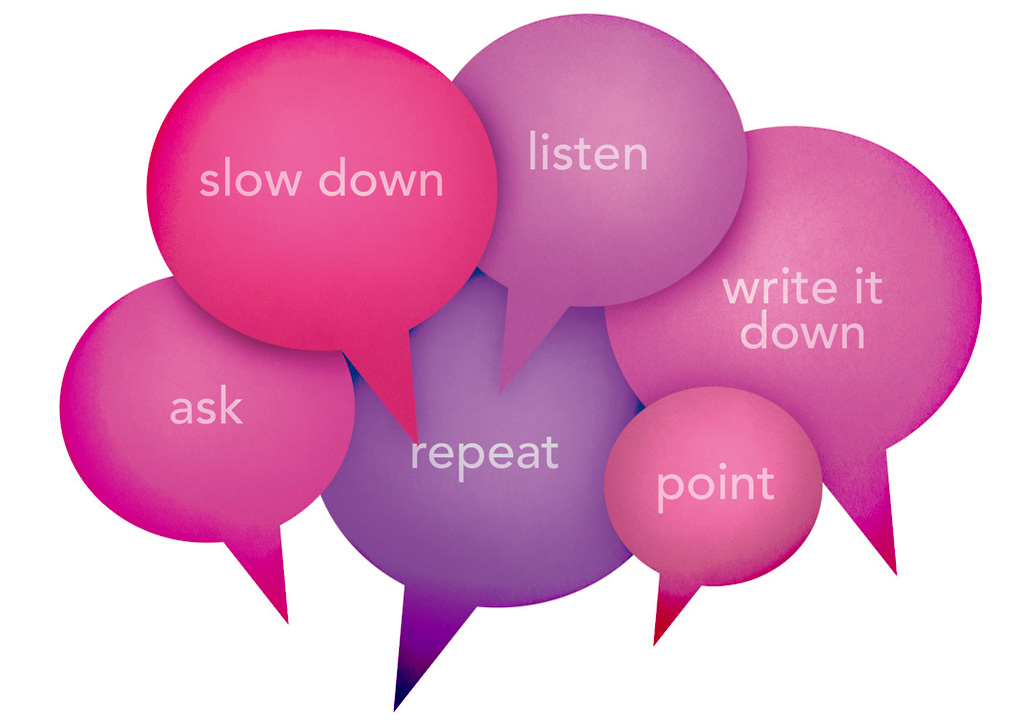We communicate our thoughts, ideas and feelings to others in many ways. We do it with words—spoken or written. We communicate through the use of voice, hand gestures, and face and body movements.
After a stroke, communication problems are common. You may find yourself using the wrong word or not able to create sentences. Or you may repeat yourself. You may misunderstand what people are saying. You may find that you are unable to read and write. “Aphasia” is the term given to these problems with communication. You may also find yourself having slurred speech. “Dysarthria” is the term given to this problem with speech.
Aphasia
There are two types of aphasia: expressive and receptive. With expressive aphasia you know what to say, but the words come out wrong. The words may be jumbled, not make sense or be totally different from the words you wanted to say. With receptive aphasia you can hear spoken words and see written words, but have a hard time knowing what they mean. You may also take word meanings very literally and be unable to understand some forms of humour.
Expressive and receptive
Some people with stroke may have both expressive and receptive aphasia. Either type makes it hard to read, write, work with numbers, join in conversations, and share thoughts and feelings.
Aphasia can be mild or severe, depending on your stroke. It may be temporary and improve quickly. For some people, it is long lasting or permanent.
Dealing with challenges
Aphasia can be very frustrating. You may find it hard to enjoy time with family and friends, or even to ask for what you want or need. You may find that some people treat you differently. Try to let people know how you feel. Make sure they know you are still able to join in conversations in your own way. Get those closest to you to read this article. This will help them understand what you are experiencing and give them ideas for how to communicate with you.
Your first goal may be to find a way to communicate with your family and team. Right after the stroke, you may need to use other forms of communication such as picture boards, hand signals or using a pencil and paper to draw or write words.
Strategies for communicating
Find out what part of your communication is affected. The therapist on your healthcare team who can help you with communication is called a speech language pathologist. If you are not seeing one, get a referral.
Your therapist will help identify what type of communication and speech problem you have. They will then develop a plan to help you regain communication skills. Here are some areas they may work on:
• improved understanding in conversation—asking you to match pictures to a spoken phrase
• improved ability to use the right words—asking you to name things you see in pictures
• improved ability to read—working with you to read a short paragraph and answer questions about it
• improved ability to write—practising skills needed to write
• improved ability to speak clearly—exercises to strengthen the muscles involved in speech.
Make a plan with your therapist. They can show you how to practise to improve your communication skills. Make sure your family and friends know about your plan and how they can help you communicate with them.
Reproduced with the permission of Heart & Stroke Canada. ©2018. heartandstroke.ca
Tips for family/friends
• Get the person’s attention and speak slowly.
• Give one idea at a time.
• Use questions that need “yes” or “no” answers.
• Avoid open-ended questions. Instead of asking, “What would you like to drink?” ask, “Would you like tea or coffee?” Also try asking “Can you show me?” Gesture or point to an item.
• Repeat or reword sentences.
• Write down your message using a black marker.
• Don’t interrupt.
• Pay attention to body language.
• Establish a clear general topic first and then move on to the details.
• Use short, simple sentences and an expressive voice.
• Use pictures or drawings and focus on just one at a time.
Tips for staying connected
Here are some strategies that people with aphasia use to communicate.
• Focus on one task. Don’t try to multi-task.
• Write things down before saying them. Try using short written notes. Keep a pencil and paper handy.
• Try using flashcards with keywords and pictures, such as “TOOTHBRUSH.”
• When people communicate with you in writing, they should use markers that make it easy for you to see the words. When you are writing, using a pencil is easiest.
• Use Scrabble tiles to spell out words.
• Not able to write? Try gestures, hand signals and simple picture boards to point at.
• If you have trouble finding words, try looking around to find clues from your environment.
• Computers and smartphones have apps to help with aphasia. They speak words that are typed. Or they may help you find the name of an object.
Where to get more support
100,000 Canadians live with Aphasia and their ability to stay connected and participating is key. Ask for help. Speech language pathologists are the team members who specialize in helping you communicate. To find one in your area visit aphasia.ca and check if there are aphasia support groups that meet in your community, and access information and tools for both health professionals, families and people living with Aphasia.














